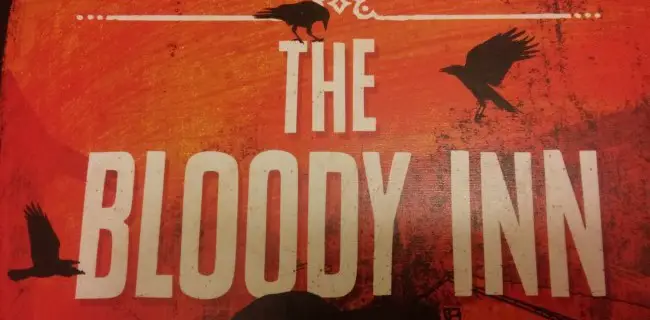France’s countryside in the 1830s was a treacherous place to travel at night. As the tavern masters of The Bloody Inn, you can show travelers that trusting the wrong people can be just as unwise. The game places you, and the players who choose to join you, as runners of a hotel seeking to outwit one another and come out with the most wealth at the end of a year of travelers making their way through your establishment. You must use trickery, strategy, and carefully calculated risks to get out on top.
The game consists of high quality cardboard game pieces and gloss cards. The cards are standard sleeve size, which is good because you will want them to last. The card art is the absolute stand-out of the game; its dark, semi-cubist portraiture sets you at immediate unease, fitting with the tone of the game. While I personally associate the style more with Spain than France, the European style helps reinforce the atmosphere of the time period and locale. The game board is small but functional, and wastes no space on the table; this is especially necessary considering that card buildup may take significant room on its own. I also need to take a moment to note a very respectful gesture by the creators: the inclusion of small plastic baggies for game pieces. It’s a small, but highly appreciated, detail that makes using the game easier for everyone.
![20151116_185516[1]](https://s226919.gridserver.com/wp-content/uploads/2015/11/20151116_1855161-620x349.jpg)
We get character, art, and culture as well as succinctly presented qualities on each card
Once players designate which rooms are theirs (giving a bonus later for surviving guests), cards from the player’s deck are placed into the rooms. Each card represents a patron of the establishment and has special properties: rank which determines their value when played to purchase or use other cards. Their annex ability grants you special bonuses when you build the card for that ability, and the Franc amount tells you how much money, or “victory points” you will receive upon killing the character. Some characters also have aptitudes for certain actions which allow you to keep them after spending them for an action. Usually characters are discarded for actions.
Each player takes a single action, followed by another single action each round. These actions all cost cards, and each is a crucial step on the road to victory. You can bribe an accomplice, taking a card into your hand, kill a guest to get their money, build a guest as an annex to use their ability, remove bodies to hide them from the police in the next phase, or launder money for more complicated reasons you will experience in play.
Because each character has so many possible uses, you are presented with fascinating choices as to how to use each card. Powerful characters, for instance, can make powerful annexes to change your game strategy, make actions less expensive, or carry enough money to make killing them a viable option to go right for victory points. Winning needs you to balance your options, your opponents’ strategies, and the usefulness each card places within those frameworks. The tension these choices create is the real meat of the game, and where it gets its flavor.
Once this initial phase is done, the police investigate. Players are penalized for unburied bodies, so the faster route to points may be devastating if they do not take the proper precautions. The game proceeds until the deck runs out of cards, and the length of game is modified by the deck’s starting size.
![20151116_185452[1]](https://s226919.gridserver.com/wp-content/uploads/2015/11/20151116_1854521-620x349.jpg)
This game is dedicated to saving you space, time, and effort as it delivers its strategic promise
The game goes from one to four players. That “one” is curious. Strategy games constantly come up against the criticism that they are essentially multiplayer solitaire, and the single player mode adds to this contention. While the game really is best when other players are thrown into the mix (and solitaire may put the owner of the game at a later advantage) it adds value to the experience without taking anything away. Nonetheless this game is nowhere near as obtuse or frustrating as similar games, and the ability to vary game length comes as a welcome option. Each player count offers different starting decks depending on if you want a shorter or longer game.
The game runs from half an hour to a little over an hour, depending on deck size, player count, and familiarity with the game. Picking it up is quick and while true mastery is at a distance nearly anyone will understand some viable strategy on their first play through. The Bloody Inn has its own flair and speed, easily distancing itself from many of its more sterile competitors.
The Bloody Inn
Designed by: Nicholas Robert
Published by: Asmodee Games
Players: 1 to 4
Ages: 14 and up
Time: 30-60 Minutes
Mechanics: Strategy, Hand Management
Weight: Medium
MSRP: $20.00
John Farrell is an attorney working to create affordable housing, living in West Chester Pennsylvania. You can listen to him travel the weird west as Carrie A. Nation in the Joker's Wild podcast at: https://jokerswildpodcast.weebly.com/

The Bloody Inn is an accessible though satisfying strategy experience. Its dark theme may not interest all, but the art and structure add to the mood of a savage struggle for dominance in its unique though familiar take on rural France.
PROS
- Simple yet deep strategy with elegant resources
- Dark cubist portraits immediately translate theme
- Can modify for shorter or longer games
CONS
- Limited player interaction
- Dark theme may turn some off
- Action management can punish last player

 Buy Now
Buy Now
 Buy Now
Buy Now
 Buy Now
Buy Now
 Buy Now
Buy Now
 Buy Now
Buy Now
 Buy Now
Buy Now















